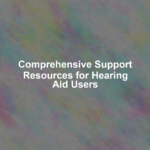Just as a seasoned gardener knows that the right combination of sunlight, water, and nutrients is essential for a garden to flourish, you must realize that navigating the world with a hearing aid requires a tailored blend of resources and support.
YouG??re stepping into a landscape where the nuances of technology, maintenance, and personal adaptation intertwort to define your auditory experience. Understanding the different types of hearing aids paves the way for you to select the device that fits not just your ear, but your lifestyle.
Regular maintenance, while seemingly mundane, is the cornerstone of uninterrupted auditory clarity, akin to pruning a rose to encourage its best bloom. Meanwhile, tapping into community resources and professional assistance can transform an isolating journey into a shared exploration.
As you consider the path ahead, youG??ll find that itG??s not just about the destinationG??the support you gather along the way could redefine the very nature of your hearing experience. LetG??s explore what lies ahead, where your proactive steps meet the vast horizon of possibilities.
Understanding Hearing Aid Types
To choose the right hearing aid, itG??s crucial to understand the various types available and how they differ in fit, features, and functionality.
YouG??ve got behind-the-ear (BTE) models, which hook over the top of your ear and rest behind it. TheyG??re pretty versatile and can fit almost any type of hearing loss. Then thereG??s in-the-ear (ITE) aids, which sit in the outer portion of your ear canal and are custom made to fit you.
YouG??ll also find completely-in-canal (CIC) and invisible-in-canal (IIC) options, which are smaller and less visible, but they may not have as many features due to their size. Additionally, thereG??s the receiver-in-canal (RIC) design, similar to BTE but with the speaker placed inside the ear canal for a less noticeable look and improved sound quality.
When youG??re deciding, think about what features matter to you. Do you need wireless connectivity, directional microphones, or telecoil options for phone calls? Keep in mind, smaller aids might be more discreet but could be trickier to handle if youG??ve got dexterity issues. DonG??t forget about battery life either; some aids have rechargeable batteries, while others need frequent replacements.
Your lifestyle plays a big role in your choice, so weigh the pros and cons of each type carefully.
Essential Maintenance Practices
Maintaining your hearing aid properly can significantly extend its lifespan and ensure optimal performance. HereG??s what you need to keep in mind:
-
Daily Cleaning: At the end of each day, gently wipe your hearing aid with a dry, soft cloth. Remove any earwax or debris that could block the microphone or sound port. ItG??s crucial to avoid using water or chemical cleaners unless theyG??re specifically designed for hearing aids.
-
Moisture Control: Humidity and moisture can damage your device. Store it in a dry, cool place and consider using a hearing aid dehumidifier overnight to help prevent moisture buildup.
-
Regular Filter Changes: Your device may have a wax filter that protects the internal components from earwax and other particles. Check and replace these filters regularly to prevent any blockage that could impair functionality.
-
Professional Check-ups: DonG??t skip your scheduled appointments with an audiologist or hearing aid specialist. TheyG??ll carry out a thorough cleaning and check-up, ensuring that any potential issues are addressed before they become serious problems.
Maximizing Hearing Aid Performance
Ensuring your hearing aidG??s peak performance involves more than routine maintenance; itG??s about optimizing its settings to match your daily environment. YouG??ve got to be proactive, regularly checking and adjusting to ensure youG??re getting the clearest sound possible.
Start by getting to know your deviceG??s features. Does it have directional microphones? Use them to focus on conversations in noisy places. Is there a telecoil setting? Switch it on during phone calls or when using loop systems in public venues. And donG??t forget to explore any personalized programs your audiologist has installedG??these are tailored to your specific hearing needs.
You also need to consider your lifestyle. If youG??re active outdoors, adjust settings to reduce wind noise. For music lovers, fine-tune the frequency response to enhance sound quality. And if youG??re often in meetings or lectures, ensure your hearing aid maximizes clarity for speech.
Community and Peer Support
Navigating the world with hearing aids becomes significantly easier when you connect with communities and peers facing similar challenges. Sharing experiences and advice can provide you with the emotional and practical support thatG??s essential for your journey. YouG??re not alone, and these support systems can play a crucial role in helping you adapt to life with hearing aids.
HereG??s how you can benefit from community and peer support:
-
Shared Experiences: Engaging with others who wear hearing aids offers you a sense of camaraderie. YouG??ll find comfort in knowing that your struggles are understood, and your successes celebrated, by those who truly comprehend your journey.
-
Practical Advice: YouG??ll gain access to a wealth of knowledge from others whoG??ve navigated similar paths. They can offer tips on maintenance, troubleshooting, and even recommend audiologists or specific hearing aid models.
-
Emotional Support: Sometimes, you just need to talk to someone who gets it. Peer support provides a safe space for you to express your feelings and receive empathy and encouragement.
-
Advocacy and Awareness: As part of a community, you can join forces to advocate for better services, accessibility, and public understanding about hearing loss and hearing aids.
Professional Assistance and Training
While community and peer support offer a strong foundation, seeking professional assistance and training can elevate your understanding and management of your hearing aids. YouG??ll find that audiologists and hearing aid specialists donG??t just fit you with devices; theyG??re also invaluable resources for ongoing support and education.
TheyG??ll guide you through the nuances of your devices, including how to adjust settings for different environments, manage maintenance, and troubleshoot common issues. ItG??s crucial to attend follow-up appointments and training sessions. These meetings ensure your hearing aids function optimally and youG??re comfortable managing them.
Moreover, you might be offered auditory training. This specialized training helps your brain better process the sounds youG??re now able to hear with your hearing aids. ItG??s particularly beneficial if youG??ve experienced hearing loss for an extended period before getting aids.
Conclusion
YouG??ve explored the ins and outs of hearing aids, from the variety of types to essential upkeep. By maintaining and optimizing your device, youG??ll get the most out of it.
Remember, youG??re not alone. Lean on community support and professional guidance to navigate challenges. With these resources and a proactive approach, youG??ll enhance your hearing experience.
Embrace the journey and the newfound clarity it brings to your daily interactions.










